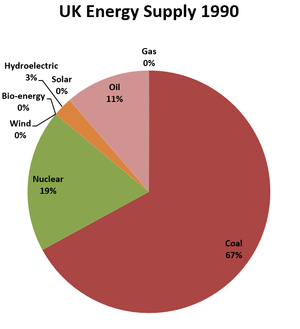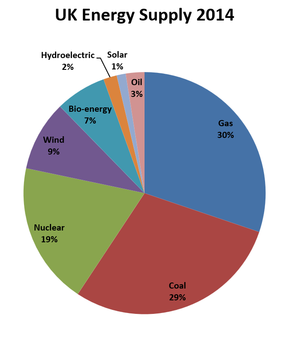Difference between revisions of "Energy Resource"
(→Future Trends) |
(→Future Trends) |
||
| Line 61: | Line 61: | ||
|[[File:UKEnergySupply2014.png|center|300px]] | |[[File:UKEnergySupply2014.png|center|300px]] | ||
|- | |- | ||
| − | |colspan="2"|The [[percentage]] of the [[United Kingdom]]'s [[electricity]] generated by different '''energy resources'''. There is a clear decrease in the use of [[Coal]] and an increase in the use of [ | + | |colspan="2"|The [[percentage]] of the [[United Kingdom]]'s [[electricity]] generated by different '''energy resources''' in 1990 and 2014. There is a clear decrease in the use of [[Coal]] and [[Crude Oil]] and an increase in the use of [[Natural Gas]] and a number of [[Renewable Energy Resource]]s. |
|} | |} | ||
| + | The current trend suggests that the use of [[Renewable Energy Resource]]s will continue to increase in the future. However, since [[Wind Power]] is unreliable and cannot be altered to meet demand, there will likely be a need for [[Natural Gas]] to generate [[electricity]]. | ||
Revision as of 23:37, 2 February 2019
Contents
Key Stage 3
Meaning
An energy resource is a part of the environment that has a store of energy which can be used by humans.
About Energy Resources
- Energy Resources are used for heating and lighting our homes as well as provide energy for transport and industry to build products.
- Energy resources are split into two groups; Renewable and Non-renewable.
Key Stage 4
Meaning
An energy resource is a part of the environment that has a store of energy which can be used by humans.
About Energy Resources
- Energy Resources are used to heat homes and to generate electricity.
- Energy resources are split into two groups; Renewable and Non-renewable.
Trends in the use of Energy Resources
Daily Trends in Energy Use
- The amount of electricity used and how it is generated changes over time.
- To meet the changing demand for electricity companies must be able to increase or decrease the amount of energy needed quickly.
The following energy resources can be used to quickly increased or decreased electricity production to meet the demands:
- Natural Gas - The amount burned can be changed at a moments notice.
- Nuclear Fuel - The rate of reaction can be changed quickly.
- Hydroelectric - The amount of water allowed through the dam can be varied quickly.
- Tidal - The amount of water allowed through the barrage can be varied quickly.
Future Trends
Many Governments are trying to decrease their reliance on Fossil Fuels because:
- The produce Carbon Dioxide which scientists have linked to Global Warming
- Fossil Fuels will run out one day so we need an alternative to provide electricity.
The use of Renewable Energy Resources is likely to increase over the next few years while the use of Non-renewable Resources such as Coal, Crude Oil and Natural Gas are likely to decrease.
| The percentage of the United Kingdom's electricity generated by different energy resources in 1990 and 2014. There is a clear decrease in the use of Coal and Crude Oil and an increase in the use of Natural Gas and a number of Renewable Energy Resources. | |
The current trend suggests that the use of Renewable Energy Resources will continue to increase in the future. However, since Wind Power is unreliable and cannot be altered to meet demand, there will likely be a need for Natural Gas to generate electricity.

